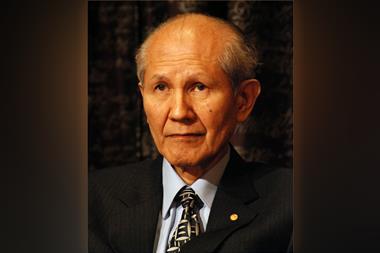Chalfie, Shimomura and Tsien share 2008 chemistry award
The 2008 Nobel Prize in Chemistry has been awarded jointly to Japanese scientist Osamu Shimomura and US researchers Martin Chalfie and Roger Tsien, for the discovery and development of the green fluorescent protein (GFP).
The protein, first isolated from a jellyfish, is now routinely used as a brightly glowing marker to track the positions and interactions of proteins in cells.

Professor Lars Thelander of the Royal Swedish Academy of Sciences, speaking just after the announcement, said GFP was a wonderful tool that makes it possible to study metabolism and reactions inside living cells without destroying them. It is now very easy to label proteins with fluorescent markers, Thelander added, noting that GFP is already helping to provide new insights into the cellular processes associated with diseases such as cancer, HIV and Alzheimer’s disease.
Chemical groundwork
Osamu Shimomura was the first to identify and isolate GFP, which is responsible for the characteristic bioluminescence of the jellyfish Aequorea Victoria. Shimomura, then at the University of Princeton, and now based at the Marine Biological Laboratory in Woods Hole, Massachusetts, gathered extracts from more than 10,000 jellyfish over the summer of 1961 to find a protein that glowed bright green under UV light.
Shimomura’s meticulous studies into the chemistry of this glowing protein laid the groundwork for the next step. In the early 1990s, Martin Chalfie, now at Columbia University in New York, uncovered the jellyfish gene that was responsible for making GFP and integrated it into the genetic code of E. coli bacteria. Chalfie was surprised to find the cells glowing brightly, despite having none of the jellyfish enzymes or chemicals that were thought to be needed.
Although many organisms can fluoresce brightly, such as fireflies and tropical fish, the chemical processes usually involve other components that are used up during the luminescence. Chalfie found that GFP was unique - only requiring oxygen to power the conversion of ultraviolet light into a bright visible shade of green light. Continuing his investigations with the millimetre-long roundworm C. elegans, Chalfie realised that fluorescent GFP tags could potentially be attached to any type of living cell by inserting the gene at specific locations in DNA.
Glowing commendation
However, there were still problems using GFP practically as it tended to lose its ability to glow over time and green was not an ideal colour for detailed studies. Roger Tsien, now at the University of California in San Diego, made various mutations in the gene, creating new variants of GFP that shone more strongly and in different colours, from blue to red and yellow.
Jeremy Sanders, who supervisedTsien during his PhD at the University of Cambridge, says that it is a good time for GFP to be recognised. ’Roger’s work, even before GFP, has opened up a whole new world for looking inside living cells,’ Sanders told Chemistry World. ’Today you can buy these compounds commercially and they have completely transformed the field of molecular biology.’
Thanks to Tsien’s work, many different cells can be tracked in real time - allowing them to be studied as they interact, metabolise chemicals or divide. From humble beginnings as an obscure jellyfish protein, GFP has now changed the way we look at the dynamic world of cellular life.
Woken from his sleep at 3am to hear the announcement, Tsien spoke on the phone at the press conference in Sweden. ’I am very honoured and pleased that this work could be recognised,’ he said, adding that he was surprised to have been chosen for the award. ’This is the work of a lot of people, but the three of us will have to serve as figureheads.’
Each of the three researchers will receive an equal share of the 10 million Swedish Kroner (?800,000) prize pool.
Lewis Brindley
Enjoy this story? Spread the word using the ’tools’ menu on the left







No comments yet